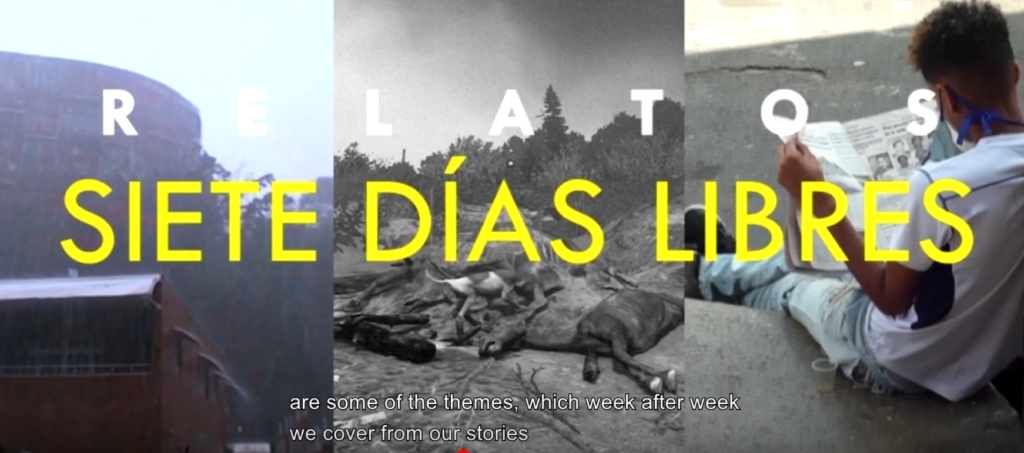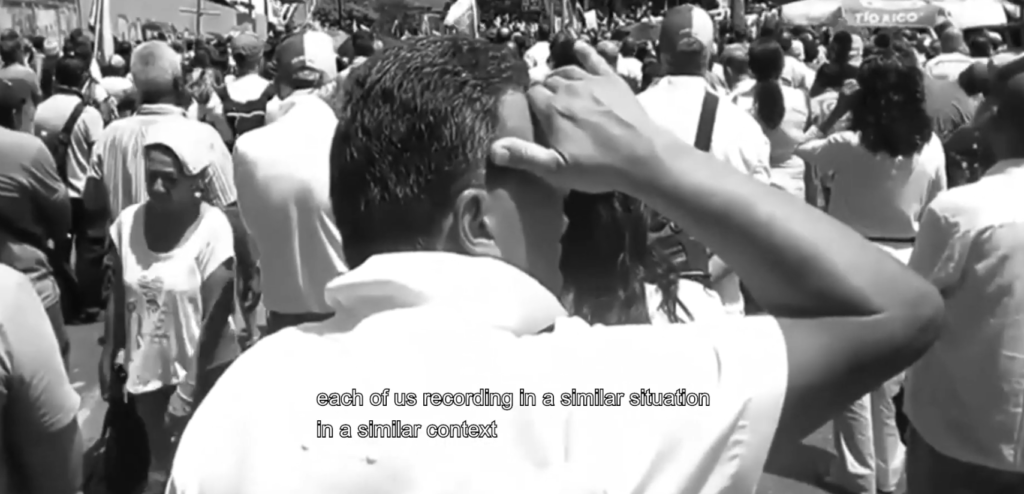Some reflections of the Zona de Despeje 3: En La Mesa by Ileana Ramírez, Directora de Tráfico Visual.
“An image, as a concept, that can lend to so many types of messages, […] it’s often used so much that we can understand it with our eyes closed, without even having to look at it” Harun Farocki
An obsession with constructing stories with multiple images and videos in a sort of cinematic montage, capable of inhabiting a virtual space on the Internet, is what drives the members of En La Mesa, an audiovisual production platform which works from Caracas, Venezuela.
Kyril Elneser, Ezequiel Carías and Ricardo López met during Film School in Caracas, where their friendship and desire to create drove them to establish a way to experiment with media they created and images found on social media, viral videos, and archival footage. On other occasions simple contemplation proves the perfect material to compose a sound sequence and video. Often times, these clips have no beginning or end, they create illusions and help imagine worlds that don’t exist, in hope that every video will inevitably captivate our attention in through the continuous thread of moving images.
When Ricardo, Kyril and Ezekiel began their daily practice of composing stories or combining moving images, they had the urgent need to record and bear witness to the tragedies that were gripping Venezuela (specifically to the 2019 blackout). Observing and capturing the despair, as well as people’s ingenuity in founding solutions amidst the absence of electricity, was a driving motivation for them to record what was happening. From this, their first series called Memorias [Memories] was born.
Once the first season of Memorias [Memories] was over, they began working on Guaire or Memorias II [Memories II], an approach through sound, image, and textures to the banks of the polluted river that crosses the city of Caracas. Soon after beginning this creative endeavor, the coronavirus crisis and mandatory quarantine interrupted their production but sparked a new series, Relatos de cuarentena [Quarantine Stories]. This 40 chapter project was published on their Instagram account, @enlamesa0. In this series they combined existing images circulating on the Internet, with videos and images they took of everyday situations and the dynamics of the “new normal”.
The editing and montage in Guaire operate as a methodology, presenting many ways to approach a space with great symbolic load. Through shots of people’s faces and atmospheric images and sounds, En La Mesa brings us close to the contaminated river that splits Caracas in half, where, as their work shows, is the stage for many dramatic and surreal things.
“The act of expressing yourself under any context is already important, this time we had to do it with a virus. We have decided to adapt ourselves to this pandemic, this is a historical fact. We maintain the conviction that in the midst of this disruption there are stories that deserve to be told.
Each of us has a personal reason why we feel the need to express themselves: to beat adversity, to make sense within chaos, to evidence that we were here. All three of us agree that we need to keep working regardless of circumstance”.2
En La Mesa’s video essays, in which they at the times are also actors and provocateurs, have their own language, a texture and time that moves easily and lightly within the format for which they create (Instagram or Youtube). Our device’s screens become a digital space to bear witness to what happens in the vicinity of the Guaire River.
Many are the reasons for Venezuela’s long-standing cultural isolation, to which we can ad Covid-19 and an extended quarantine with no end in sight. These circumstances, however, do not disturb En La Mesa’s work. Through the decontextualization that emerges from their never-ending experimentation, the collective subverts the traditional structure of storytelling to forge new meanings from these everyday images.
About En La Mesa
Ezequiel Carías Domínguez (@ezevisual) was born in Caracas on February 17, 1994. Carías Domínguez studied at the Escuela Foto Arte, Roberto Mata Taller de Fotografía, La ONG in Caracas and the National School of Cinema. Thesis Student from the School of Arts UCV, Major in Filmography. Teacher at the National School of Film and Teaching Assistant at UCV. He has deepened his Audiovisual work as a documentary filmmaker in personal projects together with fine artists, filmmakers and communities.
He currently has several photographic and film projects, acting as director, producer, director of photography and art assistant. Director of 4 short films.
Ricardo López Prada (@rtlopezprada) was born in Anaco, Anzoátegui state on December 31, 1988. He spent his childhood in several cities in eastern Venezuela and Mexico and studied mechanical engineering at the Barcelona chapter of the Univesidad de Oriente, at the same time took several film and photography workshops. In 2016 he moved to Caracas to study film at The National School of Film. He currently lives in Caracas where he works as an audiovisual filmmaker.
Kyril Elneser (@kyrilelneser) was born on May 28, 1993 in Puerto La Cruz, Anzoátegui state where he took several film courses and began his audiovisual career. At the age of 22 he moved to Caracas to study at the National Film School in Caracas, where he has had the opportunity to develop his skills in specific areas such as post-production of sound, direct sound and musicalization. He currently lives and works in Caracas, where he does audiovisual and musical production. He is a co-founder of the audiovisual collective “En La Mesa” and is the founder of the audiovisual platform Cero Uno.
_____________________________________________________________________________
1 As Farocki says in the commentary of Arbeiter verlassen Die Fabrik (Workers leaving the factory), made in 1995 on the occasion of the centenary of the first film made by the brothers LumiEre.|https://www.harunfarocki.de/films/1990s/1995/workers-leaving-the-factory.html
2 Interview with members of THE TABLE published in traficovisual. May 5, 2020
Ileana Ramírez Romero
November, 2020
Translated by Ana Mosquera.




